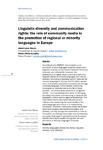Linguistic diversity and Communication rights: the role of community media in the promotion of regional or minority languages in Europe

Use this link to cite
http://hdl.handle.net/2183/18410
Except where otherwise noted, this item's license is described as Recoñecemento-NonComercial-SenObraDerivada 4.0
Collections
- Investigación (FEDU) [938]
Metadata
Show full item recordTitle
Linguistic diversity and Communication rights: the role of community media in the promotion of regional or minority languages in EuropeDate
2016Citation
Lema Blanco, I. & Meda González, M. (2016). Linguistic diversity and Communication rights: the role of community media in the promotion of regional or minority languages in Europe. Radio, Sound & Society Journal, 1(1), 26-41.bv
Abstract
[Abstract] According to the UNESCO, the translation and promotion of local languages supports cultural and linguistic diversity and provides a basis for the social, economic and cultural life. However, the globalisation of digital media is having a direct and negative impact on minority languages and cultural diversity. According to Eurolang (2014), there are 60 minority languages in Europe and 50 million people (10 % of European population) communicate through a minority language. In this context, community media play an essential role in the life of these peoples – as the European parliament recognised (2008) – by consolidating their sense of belonging, providing information and becoming a space for the expression of local and/or regional sensitivities. The Third Media Sector also fulfils educational and cultural aims, preserving the local identity of the native language and culture in a contemporary framework. Therefore, community media are indeed social technologies that reinforce pluralism and diversity, not only through the production of radio or TV content, but through democratic and participatory processes that support and reinforce the European identity and cultural wealth through the use and promotion of minority languages of Europe.
Keywords
Minority languages
Community media
Linguistic diversity
Local identities
Community media
Linguistic diversity
Local identities
Rights
Recoñecemento-NonComercial-SenObraDerivada 4.0






